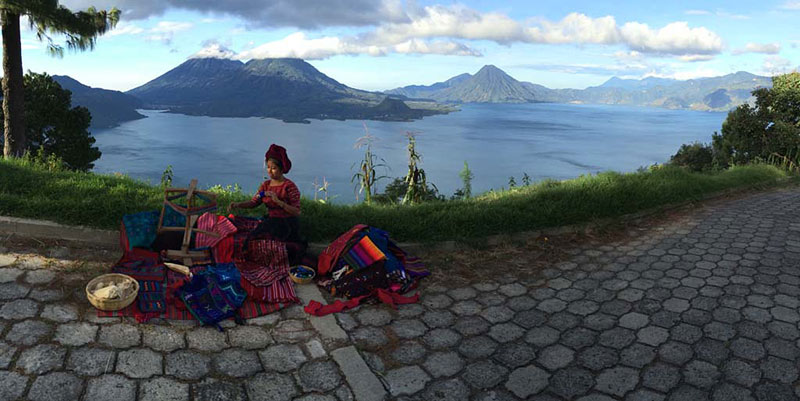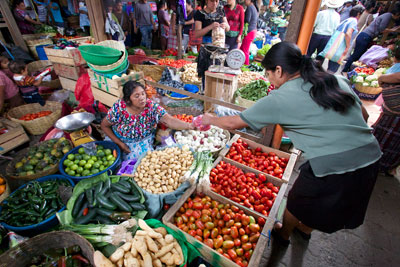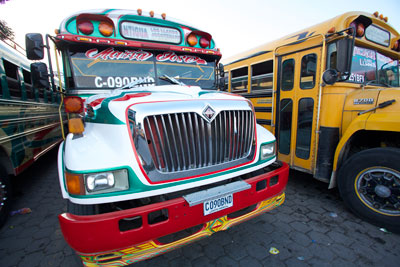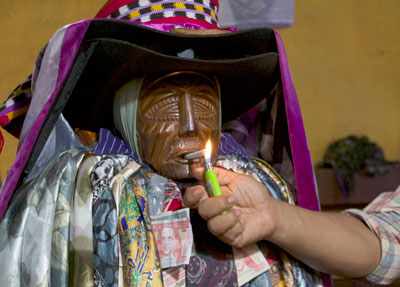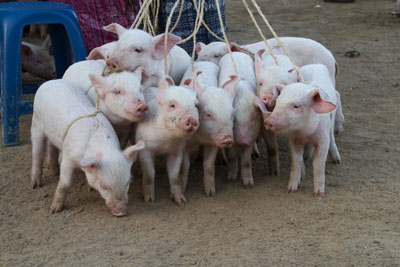Focusing on Guatemala’s ‘living Maya’
This article appears on page 6 of the November 2015 issue.
The thump of bus tires on cobblestone streets announced our arrival in the city of Antigua, Guatemala. Six miles to the south, Volcán de Agua peered shyly through its cloud cover, reminding visitors that this is a land of volcanoes and welcoming our small photo-tour group to the Highlands of Guatemala, where our leader, Jim Cline of Jim Cline Photo Tours (San Diego, CA; 877/350-1314, jimclinephototours.com), promised to show us its remarkable landscape and share a more intimate view of a Mayan culture he called “the living Maya.”
Antigua
On arrival by chartered bus from the airport in Guatemala City, an hour to the west, our group of six photographers checked into La Posada de Don Rodrigo, at the center of Antigua, where my wife, Margaret, and I began our 10-day, November 2014 excursion to the Highlands.
After exploring the lush interior courtyards characteristic of many Guatemalan hotels, we were encouraged to walk around the city on our own. Street vendors crowded the streets, selling brightly colored weavings and textiles as souvenirs.
To explore Antigua away from the area of hotels, Margaret and I walked toward the western edge of town to Calle de Recoletos, where we discovered a busy bus depot next to one of the food markets. This was our introduction to the world of “chicken buses” that we had read so much about back in the States.
Chicken buses are usually retired school buses from the US that are sold at auction and brought through Mexico to Central America for local use. Most undergo a dramatic makeover — hydraulic brakes replaced with air brakes, automatic shift changed to manual and gasoline engine to diesel, with all manner of designer embellishments in vivid colors and flashy graphics added.
You won’t see many chickens carried on the buses these days, except, perhaps, in more distant, rural locations. Locals refer to the buses simply as camionetas.
Inexpensive fares make camionetas the transport of choice for locals. (In April 2015, a ticket for travel from Antigua to Guatemala City cost 9 quetzales, or about $1.15.)
Other ways to move around the city, besides walking, include the motorcycle-driven tuk tuks (rickshaws), which have side flaps to protect passengers from the weather. There are even horse-drawn carriages.
Buses other than camionetas are available in different sizes and capacities and are chosen mostly by visitors who want a more luxurious travel experience.
Back to the city center in the afternoon, we ate lunch at Café Condesa (Portal del Comerico 4), where dining tables sat in garden courtyards and soup and sandwich meals were available ($2.50-$6.50, on average), followed by a rich assortment of cakes and pies that changed every day. The café was also a bookstore, a low-key travel agency, called Antigua Tours, and a compelling photo gallery with portraits of Guatemalans.
At the end of our trip, we used Antigua Tours (phone +502 7832 0053, antiguatours.net) for a visit to a nearby coffee plantation called Filadelfia.
A colorful visit
On our second day in Antigua, Jim had arranged for us to travel to the home of a young Mayan woman named Maritza in the nearby town of San Antonio Aguas Calientes. The town is known for its weavers, and our visit that day was a special opportunity to see their talent firsthand.
Maritza was dressed in a multicolored huipile, the kind of blouse or tunic that Mayan women wear together with a skirt called a corte. The traditional color of textiles in San Antonio Aguas Calientes is blue, but Maritza had chosen an outfit of red, blue and purple floral patterns that sparkled in the shafts of sunlight that came through the partially open roof.
As we entered her home, we were introduced to Maritza’s extended family: her sister, mother and cousins, all of whom were busy either preparing tortillas on an indoor wood fire framed by cinder blocks or using what are called backstrap looms to show us how they had created the floral patterns we saw everywhere on display.
A backstrap loom can be set up just about anywhere, indoors or out, by attaching one end of the loom behind your back and the other to a hook or fixture along a wall. One of Maritza’s aunts was busy creating a brocade pattern of flowers out of cotton thread.
Our group of photographers relished the images we were able to take of this welcoming Mayan family, who might normally be reluctant to share their daily lives. We gave something back by purchasing table runners, huipiles and jewelry.
As we said good-bye to them at the Catholic church where we had first arrived, a marriage ceremony’s fireworks sent us on our way back to Antigua.
Panajachel
On the morning of our third day, we traveled by a small bus 30 miles west to Panajachel, on the edge of Central America’s deepest lake, Lake Atitlán. The lake is over a thousand feet deep and, as at the city of Antigua, three volcanoes overlook it.
Our next two evenings were spent at Posada de Don Rodrigo Panajachel, a sister property to the hotel of the same name in Antigua. Our group had rooms that faced the lake, the three looming volcanoes framing the dramatic landscape.
Following breakfast at the hotel the next morning, we visited a small on-site museum for an introduction to the geology and archaeology of the region and learned about the discovery of a flooded Mayan city across the lake near Santiago Atitlán.
We would spend the rest of the morning and afternoon visiting two villages, San Antonio Palopó and Santa Catarina Palopó, courtesy of a small motor launch.
Jim has developed many friendships in these traditional villages, and in 2002 he became godfather to Yulissa. Yulissa’s cousin Maria would serve as our local guide for part of our visit.
To get to these villages, we made the steep climb into the hills above the lake on a narrow path where no vehicles or pack animals could go.
As with homes we had seen back in San Antonio Aguas Calientes, cinder blocks replaced adobe bricks for house construction because of the threat of earthquakes. We entered a large courtyard, where family members, including mothers, fathers, grandparents and children, welcomed us and where 12-year-old Yulissa greeted us shyly.
We were treated to displays of huipiles and decorative weavings in the distinguishing colors of this village, rich blues and greens. Jim shared photos that he had taken of the family in previous years, then he led us to the house of Ventura, who lives with one of his sons; another son lives next door. Between his two sons, Ventura has 22 grandchildren.
The families grow onions and corn in the fields above their homes, and they use the produce to feed their families and to sell in local markets and in nearby Panajachel.
Santiago Atitlán
Across the lake from Panajachel lies the village of Santiago Atitlán. There we would visit another family, thanks to a young Tz’utujil woman named Leticia. Tz’utujil is also the Mayan language group of this area.
There are as many as 23 different Mayan languages still practiced in Guatemala, although some Spanish is spoken as well.
Leticia lives near the main docking area, where travelers generally disembark and where her mother has a small shop on the waterfront.
We got to see more huipiles on display and noticed the change to a different pattern. In Santiago Atitlán, white, light blue and light purple colors predominate, and the designs typically feature birds and flowers brocaded throughout.
As important as the traditions of weaving and small-plot farming for the living Maya are the traditional religious beliefs handed down from centuries before. And, so, after our visit to Leticia’s home, we joined our guide for the day, Humberto, who took us to one of the village’s churches, where we learned that Christian (Catholic) and Mayan religious beliefs coexist to serve both communities.
Humberto led us into the Saint James the Apostle Church, whose construction began in 1571. The structure has been restored and reconstructed many times since then because of earthquake damage.
At the altar, Humberto told us about the Mayan creation myth included in the sacred book called “Popol Vuh.” Later in the period of Spanish rule in Guatemala, which began in 1524, a Spanish priest discovered a copy of this Mayan religious text and translated it into Spanish. In it, corn is a sacred crop from which the gods created man and which is, through tamales and tortillas, the foundation of the Mayan diet today.
As we left the church, we encountered our first wooden effigy of Maximón, a Mayan shaman/saint whose presence seemed to fly in the face of orthodox Catholic belief. Maximón is celebrated in the Mayan community, and different villages each host a version of him in the house of a local family every year.
As Jim explained, “He is like a saint with great powers who can grant wishes for people — health, happiness and wealth, and also bad things for rivals or enemies. The catch is his powers are stronger when he smokes and drinks, so you must offer him not only money but cigarettes and alcohol.”
A few final photos
On our final three days in the Highlands of Guatemala, we visited the towns of Chichicastenango, San Francisco El Alto and Quetzaltenango (the latter often referred to by its Mayan name, Xela).
After an overnight at Hotel Santo Tomás in Chichi, we photographed the colorful flowers being sold on the steps of the church of Santo Tomás as well as the bustling vegetable market and the many indigenous people who had come from the numerous surrounding villages to buy or barter for goods.
The cemetery on the edge of town offered views of bright orange, turquoise and azure tombstones and included everything from simple mounds of earth to elaborate vaults for those who were buried there.
Using the Pensión Bonifaz as our base in Quetzaltenango, we traveled to San Francisco El Alto, where we observed squirming piglets, goats and chickens as they were offered for sale or barter to visitors from near and far. At the far western end of our trip, at San Andrés Xecul, we had yet another sighting of Maximón, and we explored a vibrant yellow church with red trim that featured a façade decorated with sculptures representing both Mayan and Christian beliefs.
As we ended our 12-day visit (the 10-day tour cost $4,475 per person plus $120 per night for a hotel room before and after the tour), we realized how important it had been for us to see more than the traditional tourist attractions, that our experience was greatly enriched by visits to the homes of the Mayan people whose traditions have endured for centuries despite years of persecution.
There continues to be great poverty throughout the country, especially in the Mayan communities, but we were encouraged to see the efforts that Mayan families were making to further their education and develop and sell their traditional crafts. We think visitors will find Guatemala a vibrant and meaningful destination.

